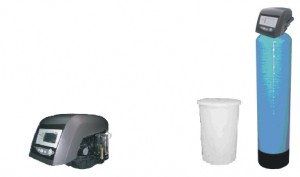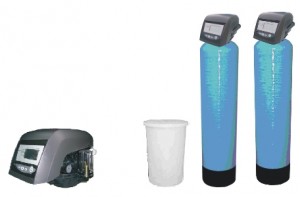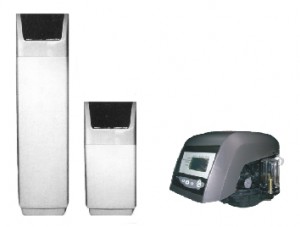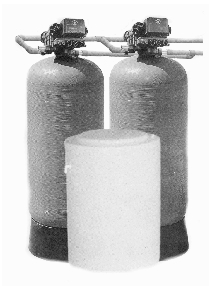Archive for January, 2009
Selective ammonia removing filter
by admin on Jan.09, 2009, under ammonia removing
SELECTIVE AMMONIA REMOVING FILTER
 |
 |
 |
 |
The process of protein decay in nature or industry may be the reason of polluting the water with ammonia. Ammonia (NH3) is well dissolving gas, which is highly toxic to water and environment.
Ammonia is most often removed from water with special selective ion exchange sorbents. These resins are regenerated with salt (NaCl). The systems of this type should work constantly and be fully automatic.
Advantages of our ammonia removing systems:
* Corrosion-proof housing
* Media lifetime till 20 years
* High durability tanks
* Fully automatic (time or volume control)
* Low operating outlays
* Water bypass in the control valve, making water flow during regeneration possible
* Possibility to control the quantity of the salt, used for regeneration, ipso facto the quantity of water between
Regenerations
* Short regeneration time
Selective nitrate removing filter
by admin on Jan.09, 2009, under nitrate removing
SELECTIVE NITRATE REMOVING FILTER
 |
 |
 |
 |
Ground waters, which are situated near leaking cesspools or agriculture areas, may be polluted with nitrates. These ions have negative influence on human organism, they may be the reason for ischemic heart disease and tumors.
Nitrates are most often removed from water with the use of selective ion exchange resins anion exchangers. These resins are regenerated with salt (NaCl). The systems of this type should work constantly and be fully automatic.
Another way of nitrate (as well as other impurities) removing is partial water demineralization with reverse osmosis systems.
Advantages of our nitrate removing systems:
* Corrosion-proof housing
* Media lifetime till 20 years
* High durability tanks
* Fully automatic (time or volume control)
* Low operating outlays
* Water bypass in the control valve, making water
flow during regeneration possible
* Possibility to control the quantity of the salt, used
for regeneration, ipso facto the quantity of water
Between regenerations
* Short regeneration time
Filter for selective heavy metal removing
by admin on Jan.09, 2009, under heavy metal removing
FILTER FOR SELECTIVE
heavy metal removing
 |
 |
 |
 |
Heavy metals are the elements, which mass density amounts to more than 4,5 g/cm3.
Heavy metals include:
* Chromium – Cr
* Zinc – Zn
* Cadmium – Cd
* Cobalt – Co
* Manganese – Mn
* Copper – Cu
* Molybdenum – Mo
* Nickel – Ni
* Lead – Pb
* Mercury – Hg
* Selenium – Sn
* Vanadium – V
* Wolfram – W
* Iron – Fe
* Selenium – Sn
Some heavy metals, called microelements, are necessary for proper functioning of the living organisms, others do not have physiological role, but there are also metals and their compounds, which are redundant or even harmful for plants and human beings. Such metals are called toxic elements and compounds.
The amount of microelements in living organisms is usually trace, typical of each species. Deficiency or excess may harm the organisms.
The toxic metals contaminate the environment. The strongest toxic properties are shown by inorganic metal compounds, which easily dissolve and decompose, due to their abilities to permeate through cell membranes and penetrate bodily organs. They accumulate chiefly in kidneys, adrenal glands, liver, lungs, even in skin and hair. Such accumulation of toxic substances may lead to high blood pressure, cancer, kidney, liver or brain damage, or even mental aberration.
Heavy metals also contaminate the environment – soil, water, air and, directly or indirectly – together with food – get into human and animal organisms.
Our special filters, for removing heavy metals are used for some sewage sorts treatment, e.g. in electroplating plants. These systems are used in industrial plants, where heavy metal concentration exceeds acceptable level. Apart from these systems, selective ion exchange process may be conducted, as the standard water purification, supplement.
Filter for selective color removing
by admin on Jan.09, 2009, under color removing
FILTER FOR SELECTIVE
color removing
 |
 |
 |
 |
Inside the soil there are constant changes in the organic matters constitution, which consist in partial decay of initial organic compounds (floral fragments) and secondary synthesis. The product of this process is soil humus, which gives the soil dark tint.
Humus compounds have complex structure. Due to their physical and chemical characteristics, they are very important for the soil formation. Nevertheless, their presence in the water makes it unsafe for drinking and industry.
In order to remove these impurities, we recommend using special, selective ion exchange sorbents. These resins are regenerated with salt (NaCl). The systems of this type should work constantly and be fully automatic.
Advantages of our humus compounds removing systems:
· Corrosion-proof housing
· Media lifetime till 20 years
· High durability tanks
· Fully automatic (time or volume control)
· Low operating outlays
· Water bypass in the control valve, making water flow during regeneration possible
· Possibility to control the quantity of the salt, used for regeneration, ipso facto the quantity of water between regenerations
· Short regeneration time




